-
Welcome back Guest! Did you know you can mentor other members here at H-M? If not, please check out our Relaunch of Hobby Machinist Mentoring Program!
You are using an out of date browser. It may not display this or other websites correctly.
You should upgrade or use an alternative browser.
You should upgrade or use an alternative browser.
Models for grinding HSS Lathe Tools
- Thread starter mikey
- Start date
- Joined
- Dec 20, 2012
- Messages
- 9,422
Back on topic, @mikey , will that cheapo HF diamond block work for honing ?
Sorry, I haven't used them before so I cannot say. I can tell you that DMT credit card stones work well, though.
- Joined
- Jan 28, 2020
- Messages
- 193
Here is a term that I don't understand the meaning: "face out". Here are examples of the term being used:
"Right Hand Knife Tool: This is a kick ass facing tool. Like all facing tools, this one cuts at the side cutting edge up close to the tip. Because all the cutting is at the side edge, the nose radius does not participate much at all and can be small; this allows you to go into the corner of a shoulder and face out without leaving a huge radius at the root/corner. The side relief angle is 15° so it takes light or heavy facing cuts easily. The back rake is more conservative and this focuses the cutting forces toward the side cutting edge, which is what we want with a facing tool." - mikey; this thread; Sept 20, 2017 (#102).
"The knife tool is really stiff but also has a rather delicate tip that allows it to get into a tight corner and face out. The tip also allows you to chamfer inside or outside corners and grooves. But what the knife tool excels at is facing. It has a long, sharp edge that allows you to skim cut a face and leave a beautiful finish, better than any other tool I’ve seen. All you need to do is get the cutting edge just off parallel with the work, come into contact and face out." - mikey; this thread; Sept 23, 2017 (#135).
"Since this tool is a general purpose tool, meaning it can turn, face or finish, it must be able to cut into a shoulder and then be able to face out. To accomplish this we will make the end cutting edge angle less than 90° so it can access corners without rubbing." mikey; the thread "How to Grind a Hss Turning Tool"; Nov 29, 2016 (#1).
I found this diagram:
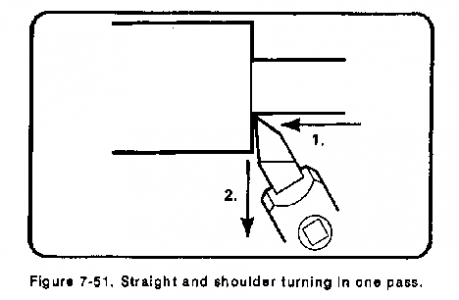
https://www.summaryplanet.com/engineering/Machining-shoulders-corners-undercuts-grooves.html
Does this diagram show what is described in the first example, "...this allows you to go into the corner of a shoulder and face out without leaving a huge radius at the root/corner", and in the third example, "...it must be able to cut into a shoulder and then be able to face out"?
Karl
"Right Hand Knife Tool: This is a kick ass facing tool. Like all facing tools, this one cuts at the side cutting edge up close to the tip. Because all the cutting is at the side edge, the nose radius does not participate much at all and can be small; this allows you to go into the corner of a shoulder and face out without leaving a huge radius at the root/corner. The side relief angle is 15° so it takes light or heavy facing cuts easily. The back rake is more conservative and this focuses the cutting forces toward the side cutting edge, which is what we want with a facing tool." - mikey; this thread; Sept 20, 2017 (#102).
"The knife tool is really stiff but also has a rather delicate tip that allows it to get into a tight corner and face out. The tip also allows you to chamfer inside or outside corners and grooves. But what the knife tool excels at is facing. It has a long, sharp edge that allows you to skim cut a face and leave a beautiful finish, better than any other tool I’ve seen. All you need to do is get the cutting edge just off parallel with the work, come into contact and face out." - mikey; this thread; Sept 23, 2017 (#135).
"Since this tool is a general purpose tool, meaning it can turn, face or finish, it must be able to cut into a shoulder and then be able to face out. To accomplish this we will make the end cutting edge angle less than 90° so it can access corners without rubbing." mikey; the thread "How to Grind a Hss Turning Tool"; Nov 29, 2016 (#1).
I found this diagram:

https://www.summaryplanet.com/engineering/Machining-shoulders-corners-undercuts-grooves.html
Does this diagram show what is described in the first example, "...this allows you to go into the corner of a shoulder and face out without leaving a huge radius at the root/corner", and in the third example, "...it must be able to cut into a shoulder and then be able to face out"?
Karl
- Joined
- Nov 14, 2016
- Messages
- 2,997
Here is a term that I don't understand the meaning: "face out". Here are examples of the term being used:
"Right Hand Knife Tool: This is a kick ass facing tool. Like all facing tools, this one cuts at the side cutting edge up close to the tip. Because all the cutting is at the side edge, the nose radius does not participate much at all and can be small; this allows you to go into the corner of a shoulder and face out without leaving a huge radius at the root/corner. The side relief angle is 15° so it takes light or heavy facing cuts easily. The back rake is more conservative and this focuses the cutting forces toward the side cutting edge, which is what we want with a facing tool." - mikey; this thread; Sept 20, 2017 (#102).
"The knife tool is really stiff but also has a rather delicate tip that allows it to get into a tight corner and face out. The tip also allows you to chamfer inside or outside corners and grooves. But what the knife tool excels at is facing. It has a long, sharp edge that allows you to skim cut a face and leave a beautiful finish, better than any other tool I’ve seen. All you need to do is get the cutting edge just off parallel with the work, come into contact and face out." - mikey; this thread; Sept 23, 2017 (#135).
"Since this tool is a general purpose tool, meaning it can turn, face or finish, it must be able to cut into a shoulder and then be able to face out. To accomplish this we will make the end cutting edge angle less than 90° so it can access corners without rubbing." mikey; the thread "How to Grind a Hss Turning Tool"; Nov 29, 2016 (#1).
I found this diagram:
View attachment 350630
https://www.summaryplanet.com/engineering/Machining-shoulders-corners-undercuts-grooves.html
Does this diagram show what is described in the first example, "...this allows you to go into the corner of a shoulder and face out without leaving a huge radius at the root/corner", and in the third example, "...it must be able to cut into a shoulder and then be able to face out"?
Karl
Yes, that is what your example shows. You will often see a small groove or relief cut at the base of a corner where you need to have two parts come together tightly. With out that groove you will often have a slight gap where the corner forms, or a small bevel on the matching face.
A narrow tool like this allows you to either make a very small groove, or if a very small gap is acceptable maybe just skip that step. Since it is useful for other operations you may not need to change tools just to finish that corner.
- Joined
- Jan 29, 2017
- Messages
- 311
Looking at your drawing, by following the arrow no 2 in that direction is known as facing out.Here is a term that I don't understand the meaning: "face out". Here are examples of the term being used:
"Right Hand Knife Tool: This is a kick ass facing tool. Like all facing tools, this one cuts at the side cutting edge up close to the tip. Because all the cutting is at the side edge, the nose radius does not participate much at all and can be small; this allows you to go into the corner of a shoulder and face out without leaving a huge radius at the root/corner. The side relief angle is 15° so it takes light or heavy facing cuts easily. The back rake is more conservative and this focuses the cutting forces toward the side cutting edge, which is what we want with a facing tool." - mikey; this thread; Sept 20, 2017 (#102).
"The knife tool is really stiff but also has a rather delicate tip that allows it to get into a tight corner and face out. The tip also allows you to chamfer inside or outside corners and grooves. But what the knife tool excels at is facing. It has a long, sharp edge that allows you to skim cut a face and leave a beautiful finish, better than any other tool I’ve seen. All you need to do is get the cutting edge just off parallel with the work, come into contact and face out." - mikey; this thread; Sept 23, 2017 (#135).
"Since this tool is a general purpose tool, meaning it can turn, face or finish, it must be able to cut into a shoulder and then be able to face out. To accomplish this we will make the end cutting edge angle less than 90° so it can access corners without rubbing." mikey; the thread "How to Grind a Hss Turning Tool"; Nov 29, 2016 (#1).
I found this diagram:
View attachment 350630
https://www.summaryplanet.com/engineering/Machining-shoulders-corners-undercuts-grooves.html
Does this diagram show what is described in the first example, "...this allows you to go into the corner of a shoulder and face out without leaving a huge radius at the root/corner", and in the third example, "...it must be able to cut into a shoulder and then be able to face out"?
Karl
When you're facing in, its towards center.
With regards to a radius in the corner, it may be desirable to have one ultimately giving that joint less chance of creating stress cracks.
And if you wish a mating part to sit flush, then chamfer the mating part taking into consideration the size of the radius.
A knife tool is just that, a sharp point.
Last edited:
- Joined
- Jan 29, 2017
- Messages
- 311
Also, please take note that when using the knife point facing out is a prerequisite to a good finish whereas facing in with this tool will create a terrible finish.
Totally dependent on the point radius.
Totally dependent on the point radius.
- Joined
- Oct 16, 2019
- Messages
- 6,570
I've been a member since Oct 2019, just over a year now and I have to make a confession.
Until tonight I have not ground a HSS tool completely following the excellent instructions in this thread.
I told myself that tonight was the night I would do it. I read the instructions, had the model for the knife tool handy and fired up the belt sander.
Quite literally, five minutes later I had a reasonable facsimile of the knife tool, sharp enough that I slipped and cut my finger while honing.
(ignore the other bevel on the middle picture that's leftover from a trepanning tool experiment)
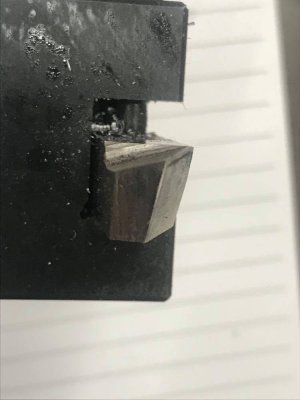
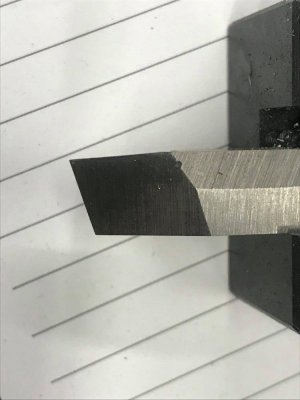
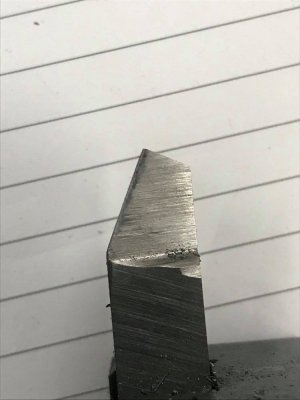
Put it in a holder, lined it up to centre and proceeded to turn some 1018 and 12L14.
Got a decent finish on the 1018, could take as light a cut as .0025 and as much as .050 with ease. The chips were tight little curls.
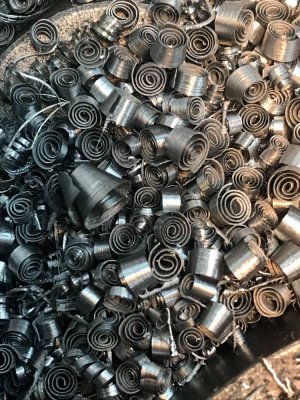
I am truly amazed and a total convert!
Thank you @mikey!
Until tonight I have not ground a HSS tool completely following the excellent instructions in this thread.
I told myself that tonight was the night I would do it. I read the instructions, had the model for the knife tool handy and fired up the belt sander.
Quite literally, five minutes later I had a reasonable facsimile of the knife tool, sharp enough that I slipped and cut my finger while honing.
(ignore the other bevel on the middle picture that's leftover from a trepanning tool experiment)



Put it in a holder, lined it up to centre and proceeded to turn some 1018 and 12L14.
Got a decent finish on the 1018, could take as light a cut as .0025 and as much as .050 with ease. The chips were tight little curls.

I am truly amazed and a total convert!
Thank you @mikey!

